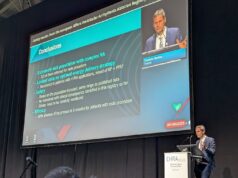
Wendy Tzou (University of Colorado School of Medicine, Denver, USA) and colleagues at the International Ventricular Tachycardia Ablation Center Collaborative group (IVTCC) published two papers (in Heart Rhythm and Circulation: Arrhythmia and Electrophysiology) in 2017 on the potential impact of radiofrequency catheter ablation for ventricular tachycardia (VT) and achieving successful ablation. Tzou presented the findings at the Euro VT/VF meeting (1–2 December 2017) in Berlin, Germany.
The IVTCC’s most recent data looked at patients undergoing a repeat radiofrequency ablation procedure for VT, finding that for the subgroup of patients in whom radiofrequency ablation resulted in a lack of VT recurrence, mortality rates significantly improved, with over 90% survival at the one-year follow-up. Furthermore, a second paper by the IVTCC observed that successful ablation with elimination of early VT recurrence in heart failure patients of New York Heart Association (NYHA) class IV—the most severe and advanced stage of heart failure—was associated with reduced mortality rates comparable to those of NYHA II and III with recurrent VT.
The IVTCC is a collaboration between 12 international tertiary-care facilities specialising in VT management. Data for both studies published in 2017 were collected from these participating centres’ patients undergoing catheter ablation between 2002 and 2013 and retrospectively analysed. The studies looked at patients with NYHA II–IV heart failure with left ventricular ejection fraction (LVEF) of less than 50%, and patients with available data on number of prior ablations, respectively. In the heart failure patient cohort (1,365), VT recurrence, mortality and clinical variables were proportionally analysed, finding significant differences in the 111 NYHA class IV patients compared to the 1254 patients belonging to NYHA classes II and III. NYHA IV patients showed more comorbidities, including diabetes mellitus and kidney disease, were more likely to have cardiac resynchronisation therapy in the form of an implantable cardioverter-defibrillator (ICD), and had a lower LVEF (30±11% vs. 21±7%). This advanced heart failure group also experienced more VT storm despite a greater use of antiarrhythmic drugs, and NYHA IV patients had higher rates of recurrent VT, in-hospital deaths and one-year mortality.
In the second study analysing 1990 ablation patients, 740 had one or multiple repeated ablation procedures, with number of repeat procedures ranging from one to ten and a mean of 1.4±0.9. Although the repeat ablation patients and the control group of patients undergoing only one ablation procedure did not differ in age (62±13 in both groups), LVEF (33% vs. 34%), sex (88% vs. 87%), the multiple ablation group had higher rates of ICD-D shocks (70% vs. 63%), VT storm (38% vs. 33%) and amiodarone antiarrhythmic drug treatment (55% vs. 48%). “Notably,” Tzou commented on the repeat ablation group, “they were more likely–in fact the majority of the repeated ablation group had non-ischaemic cardiomyopathy.”
Patients in both studies were followed as outpatients, assessing for recurrent VT, transplant and mortality. Recurrent VT or ventricular fibrillation (VF) was defined by the IVTCC as spontaneous recurrence lasting for 30 seconds or longer, as documented by telemetry, electrocardiograph (ECG), device recording, or any appropriate ICD therapy.
In the repeat ablation analysis, outcomes were “at first a little disappointing”, Tzou said. Repeat ablation patients suffered more complications (8.4% vs. 4.8%) and worse VT-free survival at one year (70.9% vs. 75.6%) as well as in overall survival (85.1% vs. 88.5%). However, Tzou explained, “if there is a success in the intermediate term, with lack of VT recurrence following ablation, not only
was survival improved for both groups but it was essentially equivalent–greater than 90% survival over a one-year period.”
Similarly, in the heart failure and VT ablation study, Tzou noted that early recurrence of VT within a month of ablation in NYHA IV patients was a strong predictor of mortality, “with a greater than eight-fold mortality rate associated.” She added, “patients like this that are taken for ablation should therefore have intense heart failure team involvements to provide contingency plans for backup should [early VT recurrence] happen, so that advanced heart failure therapies can proceed from there more expeditiously. ” On the other hand, despite significant baseline and procedural differences between groups, survival for NYHA IV patients was “remarkably improved” when recurrence was absent, with “almost statistically the same” one-year survival rates as the 68% seen in NYHA groups II and III with early VT recurrence.
A central theme at the Euro VT/VF meeting, catheter ablation discussions ranged from technology to strategy, with many cases highlighting recurrence of VT following ablation, indicating an incomplete ablation procedure, sometimes leading to one or multiple repeated ablation attempt.
Though both IVTCC studies were observational, retrospective, and relied to some extent on subgroup analysis, Tzou presented the data with encouragements for ablation performers to strive for successful ablation by using innovative techniques, optimising the use of their accessible ablation and imaging technology, and considering perseverance in ablating for VT, particularly in patients with non-ischaemic substrates. “Perseverance pays off in this population”, Tzou said in conclusion at the Euro VT/VF 2017 meeting.











